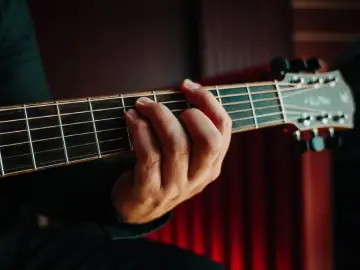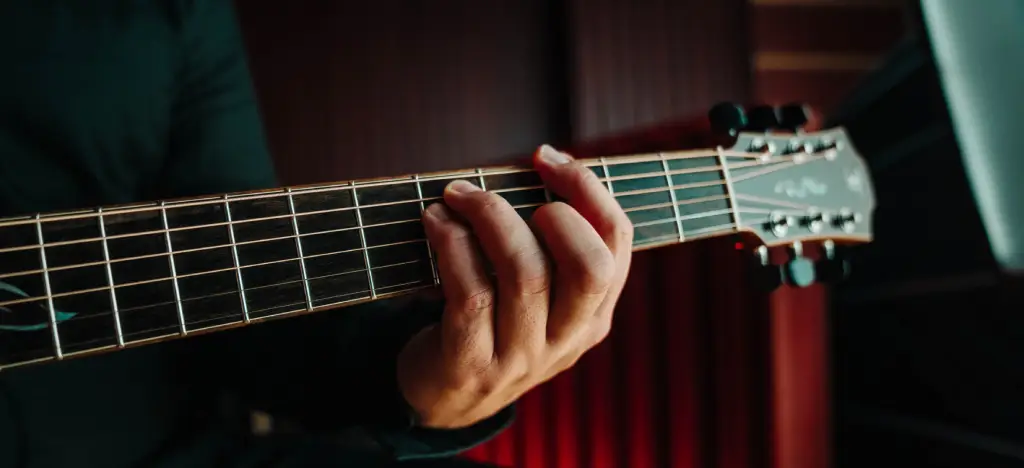Every song you love is built on chords – the fundamental building blocks of music. Learn the essential skills to play guitar chords with our comprehensive guide. Ideal for beginners and more advanced players, it includes an interactive chord chart, a free tutorial by pro guitarist Orbel Babayan, and expert tips to make your chords more interesting. Learn to read chord diagrams, master popular chord progressions, and use tools to find chords for your favourite songs.
- What is a chord?
- How to read guitar chord charts
- Free video tutorial on reading guitar chords charts
- Interactive guitar chord chart
- Main types of guitar chords
- Which guitar chords should a beginner learn first?
- Common chord progressions
- How do I make my guitar chords more interesting?
- Discover the chords to your favourite songs
- Tips for practicing guitar chords
- Want to improve your guitar playing?
What is a chord?
Let's start with the basics:
A chord is a group of three or more notes played simultaneously, creating a harmonious sound (for example the notes of C major, are C, E, and G, with C being the root note). This harmony is what gives music its depth, emotion, and character.
How to read guitar chord charts
Chord diagrams (also known as chord charts) are a beginner guitarist's best friend, and show you exactly where to place your fingers on the fretboard to make a chord.
Let’s take a look at this diagram of a C chord to find out what each part means: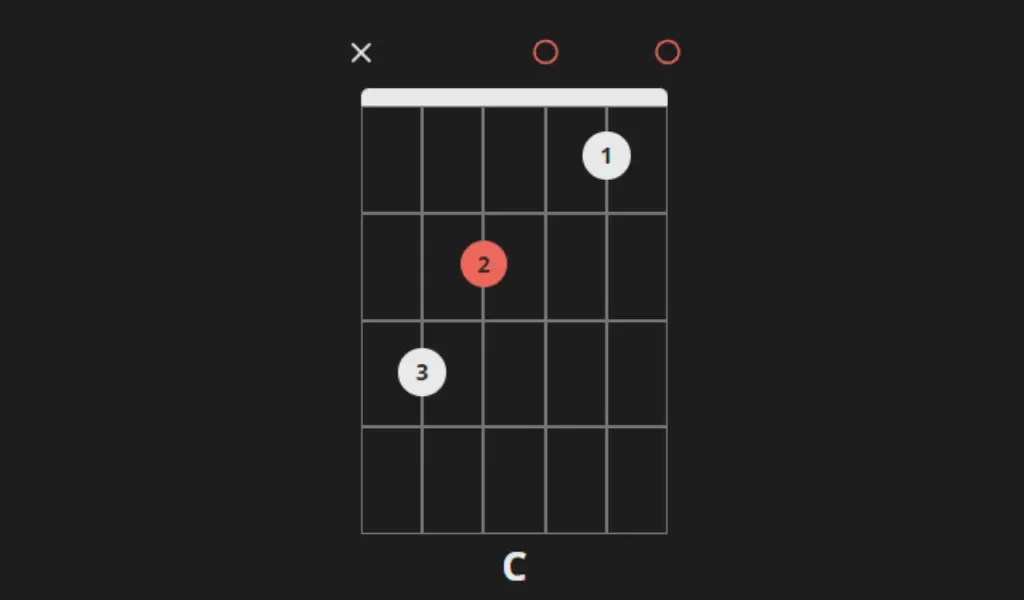
Vertical lines - Strings
The vertical lines represent the individual strings of the instrument (in this case the 6 strings of a guitar). The far left line represents the thickest string (low E on guitar), while the far right line represents the thinnest string (high E on a guitar).
Horizontal lines - Frets
The horizontal lines across the strings indicate frets, with the top bold line marking the zero fret (positioned at the headstock end of the neck).
Numbered dots - Finger placement
The dots across the frets tell you where your fingers go with each dot numbered to correspond with your fingers:
1 = Index finger
2 = Middle finger
3 = Ring finger
4 = Little finger
T = Thumb (if shown)
‘𝝬’ / ‘O’ - Mute / Play strings
A chord diagram also contains empty circles and crosses above the zero fret. Empty circles indicate open strings, whereas crosses tell you which strings to avoid playing.
Free video tutorial on reading guitar chords charts
Check out teacher and pro guitarist Orbel Babayan (Scars on Broadway) with a snippet from his Acoustic Guitar for Beginners course explaining how to read chord diagrams.
If you’re feeling inspired to pick up the guitar and start learning. Sign up for Orbel’s full course, but if electric is more your thing, try out Electric Guitar for Beginners by internet sensation Dre DiMura.
Interactive guitar chord chart
Now that you've got a handle on reading charts, explore hundreds of guitar chords with our free interactive chord chart. Perfect for beginners learning basic major or minor chords or those looking to expand into more complex, colourful chords, such as seventh chords, and suspended chords.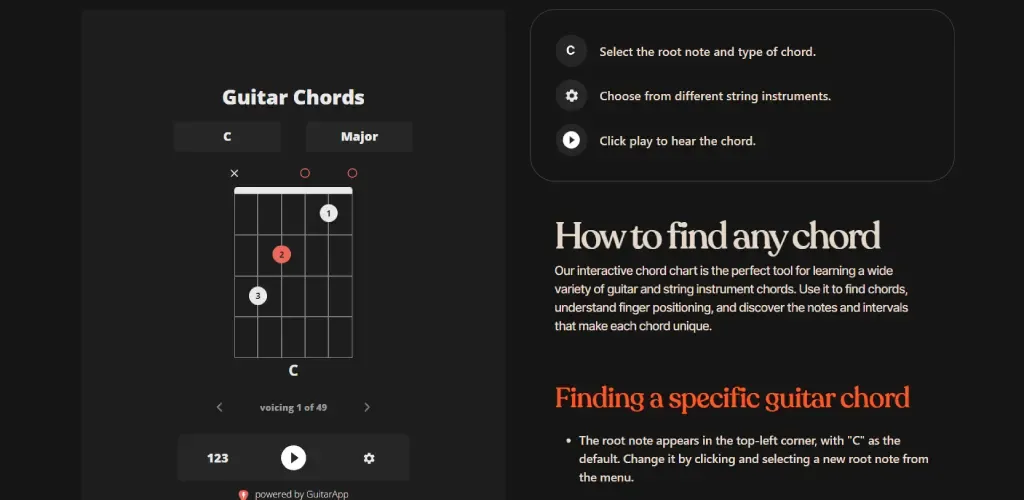 If you’re just starting out on guitar here are a few pointers to help you get strumming:
If you’re just starting out on guitar here are a few pointers to help you get strumming:
Main types of guitar chords
As a beginner, it's important to understand a few basic chord types. Here's a brief rundown of some essentials:
Major Chords: Bright and happy sounding.
Minor Chords: Softer and more somber.
Seventh Chords: Add a sense of tension or a bluesy feel.
Power Chords: Used in rock and metal, focusing on root and fifth notes.
Barre Chords: Versatile, allowing for chord shapes to be moved around the fretboard.
Which guitar chords should a beginner learn first?
C Major: The foundation of many songs, offering a clear, happy sound.
G Major: Widely used, providing a full, rich tone.
D Major: Known for its bright, uplifting quality.
E Minor: Offers a deeper, more somber tone, perfect for adding emotion.
A Minor: Easy to learn, delivering a soft, melodic sound.
… And the hardest chord to play for a beginner guitarist?: F Major (requires a barre shape)
The great news is, learning these essential chords will open up a world of popular songs for you to play!
Common chord progressions
Ever wondered how so many songs seem to share a similar feel? It's all thanks to chord progressions — the order chords are played in a song.
Practice these progressions and you'll be surprised how many songs you can play!:
The Big Three (G, C, D): This timeless trio remains a powerhouse. Think pop hits like "Perfect" by Ed Sheeran and countless chart-toppers across genres.
The Feel-Good Gang (G, D, Em): This progression continues to fuel feel-good anthems! Strum along to modern hits like "Uptown Funk" by Mark Ronson ft. Bruno Mars or "Happy" by Pharrell Williams.
The Minor Mastermind (Am, C, F, G): This versatile combo's popularity hasn't faded. Explore a range of emotions from "Someone You Loved" by Lewis Capaldi to the hopeful vibes of "A Sky Full of Stars" by Coldplay.
The beauty lies in their flexibility — you can experiment with strumming patterns and fingerpicking styles to create your own unique sound.
How do I make my guitar chords more interesting?
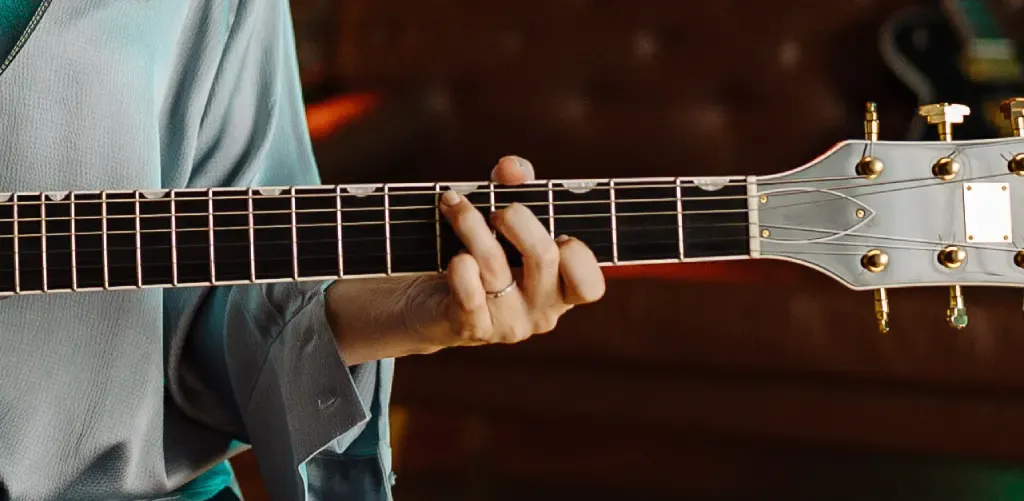 Making your guitar chords more interesting involves adding variety and complexity to your playing. Try out these:
Making your guitar chords more interesting involves adding variety and complexity to your playing. Try out these:
Extended Chords: Incorporate chords like 7th, 9th, 11th, and 13th for complex harmonies.
Suspended Chords: Use sus2 and sus4 chords to add tension and release in your progressions.
Chord Inversions: Play chords with different notes in the bass to vary their sound and texture.
Slash Chords: Experiment with chords that have a bass note different from the root for interesting voicings.
Alternate Tunings: Try tuning your guitar differently (e.g., DADGAD, Open G) for new chord shapes and sounds.
Use a Capo: Shift the capo across frets to easily change keys and explore different voicings without altering finger positions.
► ARTMASTER TIP: If you want to learn the beauty of these more complex chords now, try ArtMaster’s Color Chords Course, with chord melody enthusiast Arianna Powell — LA guitarist who's toured with Drake, Black Eyed Peas and Dua Lipa.
Discover the chords to your favourite songs
There are several online tools for finding out the chords to songs, but our personal favourite is Chordify.
Chordify is a reverse chord finder that can turn any song into chords for guitar, piano, and ukulele, offering a simple way for musicians to play along with their favourite tunes. It's a user-friendly platform with access to a vast library of songs.
Another great way to learn guitar chords through iconic songs is with our courses, developed and led by inspirational musician-educators!
Tips for practicing guitar chords
Here are some tips to help you get the most out of your practice sessions:
Start slowly: Focus on accuracy before speed.
Less hand watching: Rely on touch, not sight, for chord placement.
Lighter strings: Choose thinner strings for easier playability.
Correct posture: Good form is key for comfortable playing.
Use a metronome: Helps train your rhythm and timing.
Palm muting: Use it to add rhythm and texture.
Learn barre chords: Essential for expanding your sound.
Hand exercises: Improve strength and flexibility.
Build calluses: They minimize pain and enhance sound clarity.
► ARTMASTER TIP: To help you on your way, take a look at our collection of free customizable guitar tools, where you’ll find our chord chart generator, a metronome and a guitar tuner. And be sure to check out our guides on how to tune a guitar and practicing with a metronome.
Once you have a bit of chord practice behind you, you'll be able to start learning the chords to those songs you love.
Want to improve your guitar playing?
Learn guitar online with one of our popular online guitar courses, from beginner acoustic or electric guitar to colourful chord techniques and guitar soloing.
Try Our FREE 7-Day Trial!

